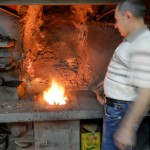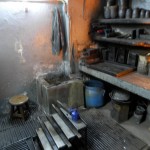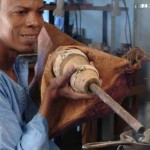We often say that jewelry making techniques haven’t really changed in thousands of years. Only the tools have been upgraded by technology. Sometimes, not even that is true.
I recently stepped back in time at least to the Middle Ages, if not to the time of the Pharoahs, when I entered a small jewelry-making shop on the second floor of the Grand Bazaar in Istanbul. As my eyes adjusted to the darkness, I saw that at the back of this brick-walled, stone-floored den was a raised hearth. On it was a bed of hot charcoal. On that rested a coil of gold. The metal worker, carefully watching the metal color and turning the coil with tongs, was annealing it in preparation for putting through the rolling mill being worked by two other men in
the center of the tiny space. (The only concession to modernity I saw was the mill.)
When the coil reached the right color—easily seen in the dim light—he picked it up and dropped it into a stone trough of water in the corner. Then he fished it out, tossed it onto the stone floor at the feet of the fellow feeding another coil through the mill. He added a bit of charcoal to his fire, and began heating another coil.
Then the other day, I read a post on Christine Dhein’s Green Jewelry News website, about her plan to travel the world learning about sustainable jewelry practices. In it, she described the work of Elhadji Koumama, a Tuareg craftsman from Niger, Africa. With–to our eyes–incredibly basic tools (making molds and crucibles out of donkey dung is pretty basic), Koumama makes really beautiful jewelry.
So why do I bring this up?
Many jewelry makers—no, many craftspersons—get a bit crazy about tools. (I know this. I paint.) They look for the perfect gizmo or widget that will allow the work to make itself. They argue about how buying the less expensive hammer from hither or the more expensive pliers from yon can affect their work. When you see jewelry produced with a goatskin bellows or a bed of charcoal, however, the arguments seem a bit hollow.
The reason, said Michael David Sturlin, as we strayed from the topic in a recent interview for Lapidary Journal Jewelry Artist magazine, is because “People want to make things, but they don’t want to learn how to properly make the thing before they start.” They don’t want to put in the—let’s face it—frustrating time to gain the skills necessary to make a high-quality final product. (Everyone who quit piano lessons in elementary school because they had to practice, raise your hand.)
Makers working in ancient traditions who do not have access to phone-book-sized tool catalogs often have a very high level of skill, said Sturlin, because they have a dedication to the craft that can be absent here. “The fewer tools they have, the more skilled they tend to be,” he said. In fact, he believes, “too many tools can be an impediment to achieving fluency in working with the material.” Like a musician or dancer, he explained, you have to invest the time in learning how to use the tool, use it correctly and learn how to do all that it will do for you.
I guess that means there isn’t a brush out there that will paint landscapes for me.




